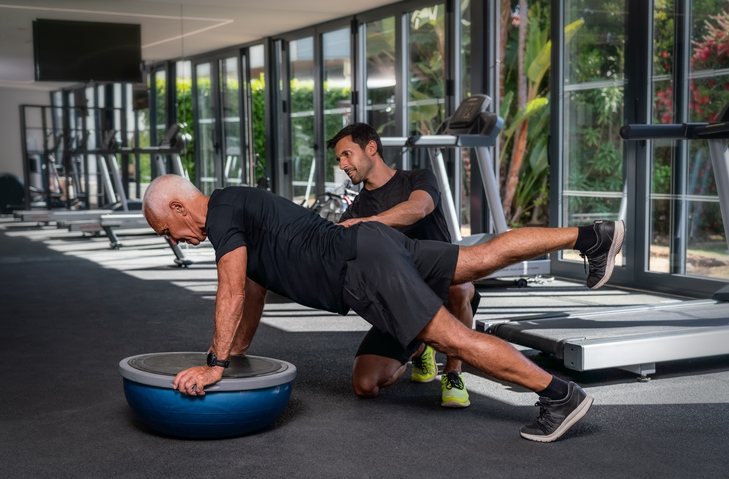
By Adam and Larry Mogelonsky
Last year, wellness debuted as the next big thing for hotels. Within the broader banner of ‘wellness’ is fitness and exercise, where most hotels have focused on getting new weightlifting equipment, buying new cardio machines, making their gyms accessible 24/7, setting up some sort of healthy food outlet, and then programming in yoga, Pilates, step or another form of group class.
What’s perhaps missed in this conversation is the importance of mobility (or substitute this word with balance training or flexibility) and how it can change one’s outlook on fitness, movement and preventing joint pain. Therein, hotels have a huge opportunity to expand their wellness footprints in a direction few others are headed.
The Aging of the Boomers
When we look into what may be contributing to the growth of fitness, a big trend is the aging of the baby boomers. They are the wealthiest generation on the planet for the rest of the 2020s, meaning that they will spur demand for treatments and consultations that can attenuate pain related to aging. Within this, a hallmark of bodily aging is a natural decline in muscle mass as well as muscle responsiveness, with ‘sarcopenia’ as one of a handful of medical terms to codify this steady, decades-long progression.
Sarcopenia explains why one’s grip strength is used as a marker for lifespan. For one, a firm squeeze is a heuristic for upper body muscle mass which is correlated with the level of activity a person maintains as they age and the health of the circulatory system. Sarcopenia and grip strength are also correlated with bone density and balance, both of which decline as we age and are further associated with chronic pain.
But equally as significant is the ‘healthy user bias’ within scientific research on grip strength in that upper body muscle helps to prevent a fall from being fatal and therefore prolongs the lifespan of those that regularly lift weights versus that don’t. While the occasional trip or accident is a matter of chance, when you are able to do a pushup or forcefully brace onto a nearby tree branch, you are thus able to use your upper body strength as a ‘preventative’ force to lessen the momentum of a fall, reducing the damage of the impact. Lest we forget that it was only a century ago – before the days of acute healthcare – when ‘falling on the stairs’ or ‘tripping on the sidewalk’ was a common cause of death.
The medical community recognizes this relationship and doctors all over the world now recommend weightlifting to their patients. However, age-driven sarcopenia is usually accompanied by the loss of integrity in the joints, ligaments and tendons, leading to chronic pain that can prevent someone from working out at a high intensity. The big opportunity for hotels and resorts therefore resides in wellness programming that caters to the management and amelioration of this pain by way of various forms of physiotherapy, massage therapy, mobility training, isometrics, yoga, pilates, stretching classes, aquafit classes and tai chi.
Stability and Balance Are Most Important for Health
Here’s another way that hotels can derive value from the growing demand for fitness that deserves some explaining. In any discussion of physical exercise, it’s important to differentiate between strength training and stability, mobility or balance work, with the latter arguably far more important for longevity and overall quality of life.
When we speak of weightlifting, many still have a stereotypical image of brooding hunks doing bicep curls or chest presses. Far less often do we mentally conjure that of balancing on one foot, squatting on a BOSU ball, using a TRX suspension system or an ‘animal flow’ class. And for reference, when we speak of ‘mobility’ we are referring to someone’s strength combined with their flexibility, as reflected in their ability to comfortably move their body across a wide range of motion at each discrete joint.
While classical barbell weightlifting is better able to drive up the heart rate and induce muscular hypertrophy for a metabolic, fat-burning boost, mobility and stability exercises work to improve mind-body connectivity, joint elasticity and the responsiveness of individual muscle striations (the units within a muscle) to thereby promote better bodily alignment and smoother joint tracking across the entirety of one’s range of motion. To put it bluntly, without joint stability, you would be in near-constant pain, preventing you from vigorously exercising and inevitably shortening your lifespan.
A simple way to think about this would be like comparing the human knee to a train chugging a track with two rails. That screeching sound a train makes as it rounds a curve results from an imbalance of weight or momentum on one side versus the other, which can be seen as analogous to the perceived pain from an uneven loading on the medial or lateral meniscus within the knee joint. Many in this situation would opt for a knee brace, but that’s only palliative and doesn’t correct the underlying issue. The real solution is to realign the loading of weight back onto the middle of the train tracks – in this case, the center of the knee – by looking at how certain muscles of the thigh are firing in tandem as well as the holistic functionality of the hip and ankle muscles.
Now Think of Your Fitness Amenities
If only people knew the critical importance of mobility, then every single physiotherapist on the planet would have a full schedule! But alas, this isn’t the case and therein lies the opportunity for hotels to inspire change in their guests by presenting these experiences – encompassing one-on-one assessments or guided classes – to them while they are in a more receptive frame of mind to try them out. Caveat emptor: this ‘sampling’ still requires a bevy of good product messaging and contextual marketing to make it worth.
While the luxury resort segment already excels in this area, the overall aging of the population combined with the increasing number of younger travelers who recognize the value of exercise will together serve as prime turf for fitness programming expansion. And because such experiences help guests live better back at home – what’s known as ‘transformation’ – a secondary benefit will be enhanced loyalty and increased customer lifetime value.
To return to the question from the title, can fitness be a primary booking driver? Yes, it definitely can be. More importantly, it should be, because all it takes is one bad fall, assisted by sarcopenia and a loss of balance, for your life to change forever. An ounce of prevention is worth a pound of cure, as they say.
The most successful hotel brands in the near future will be those that identify a growing demand niche and work to serve this desire with approachable and appropriate experiences. Our hope is that you can develop a process to evolve your fitness amenities. In an Occam’s Razor sort of way, perhaps the solution isn’t to spend six figures on those ‘state of the art’ machines but look to fill out a studio space with professional trainers who are knowledgeable in dynamic movement, yoga, animal flow and balance – the exercises that will truly help your guests and endear them to your brand.
This article may not be reproduced without the expressed permission of the authors.


